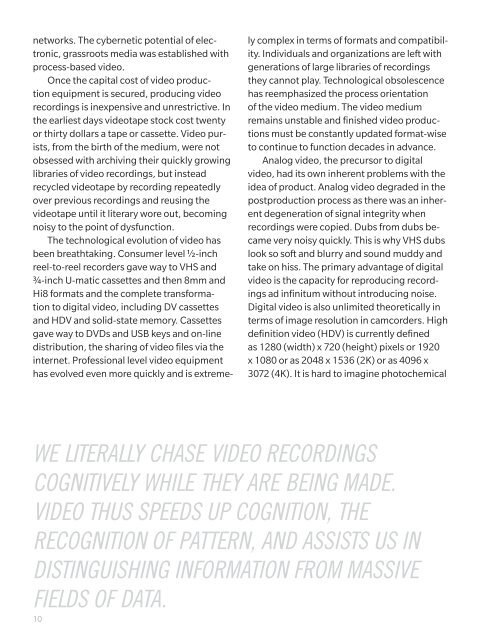video is a perceptual prosthetic - Centre for Art Tapes
video is a perceptual prosthetic - Centre for Art Tapes
video is a perceptual prosthetic - Centre for Art Tapes
Create successful ePaper yourself
Turn your PDF publications into a flip-book with our unique Google optimized e-Paper software.
networks. The cybernetic potential of electronic,<br />
grassroots media was establ<strong>is</strong>hed with<br />
process-based <strong>video</strong>.<br />
Once the capital cost of <strong>video</strong> production<br />
equipment <strong>is</strong> secured, producing <strong>video</strong><br />
recordings <strong>is</strong> inexpensive and unrestrictive. In<br />
the earliest days <strong>video</strong>tape stock cost twenty<br />
or thirty dollars a tape or cassette. Video pur<strong>is</strong>ts,<br />
from the birth of the medium, were not<br />
obsessed with archiving their quickly growing<br />
libraries of <strong>video</strong> recordings, but instead<br />
recycled <strong>video</strong>tape by recording repeatedly<br />
over previous recordings and reusing the<br />
<strong>video</strong>tape until it literary wore out, becoming<br />
no<strong>is</strong>y to the point of dysfunction.<br />
The technological evolution of <strong>video</strong> has<br />
been breathtaking. Consumer level ½-inch<br />
reel-to-reel recorders gave way to VHS and<br />
¾-inch U-matic cassettes and then 8mm and<br />
Hi8 <strong>for</strong>mats and the complete trans<strong>for</strong>mation<br />
to digital <strong>video</strong>, including DV cassettes<br />
and HDV and solid-state memory. Cassettes<br />
gave way to DVDs and USB keys and on-line<br />
d<strong>is</strong>tribution, the sharing of <strong>video</strong> files via the<br />
internet. Professional level <strong>video</strong> equipment<br />
has evolved even more quickly and <strong>is</strong> extremely<br />
complex in terms of <strong>for</strong>mats and compatibility.<br />
Individuals and organizations are left with<br />
generations of large libraries of recordings<br />
they cannot play. Technological obsolescence<br />
has reemphasized the process orientation<br />
of the <strong>video</strong> medium. The <strong>video</strong> medium<br />
remains unstable and fin<strong>is</strong>hed <strong>video</strong> productions<br />
must be constantly updated <strong>for</strong>mat-w<strong>is</strong>e<br />
to continue to function decades in advance.<br />
Analog <strong>video</strong>, the precursor to digital<br />
<strong>video</strong>, had its own inherent problems with the<br />
idea of product. Analog <strong>video</strong> degraded in the<br />
postproduction process as there was an inherent<br />
degeneration of signal integrity when<br />
recordings were copied. Dubs from dubs became<br />
very no<strong>is</strong>y quickly. Th<strong>is</strong> <strong>is</strong> why VHS dubs<br />
look so soft and blurry and sound muddy and<br />
take on h<strong>is</strong>s. The primary advantage of digital<br />
<strong>video</strong> <strong>is</strong> the capacity <strong>for</strong> reproducing recordings<br />
ad infinitum without introducing no<strong>is</strong>e.<br />
Digital <strong>video</strong> <strong>is</strong> also unlimited theoretically in<br />
terms of image resolution in camcorders. High<br />
definition <strong>video</strong> (HDV) <strong>is</strong> currently defined<br />
as 1280 (width) x 720 (height) pixels or 1920<br />
x 1080 or as 2048 x 1536 (2K) or as 4096 x<br />
3072 (4K). It <strong>is</strong> hard to imagine photochemical<br />
WE LITERALLY CHASE VIDEO RECORDINGS<br />
COGNITIVELY WHILE THEY ARE BEING MADE.<br />
VIDEO THUS SPEEDS UP COGNITION, THE<br />
RECOGNITION OF PATTERN, AND ASSISTS US IN<br />
DISTINGUISHING INFORMATION FROM MASSIVE<br />
FIELDS OF DATA.<br />
10


